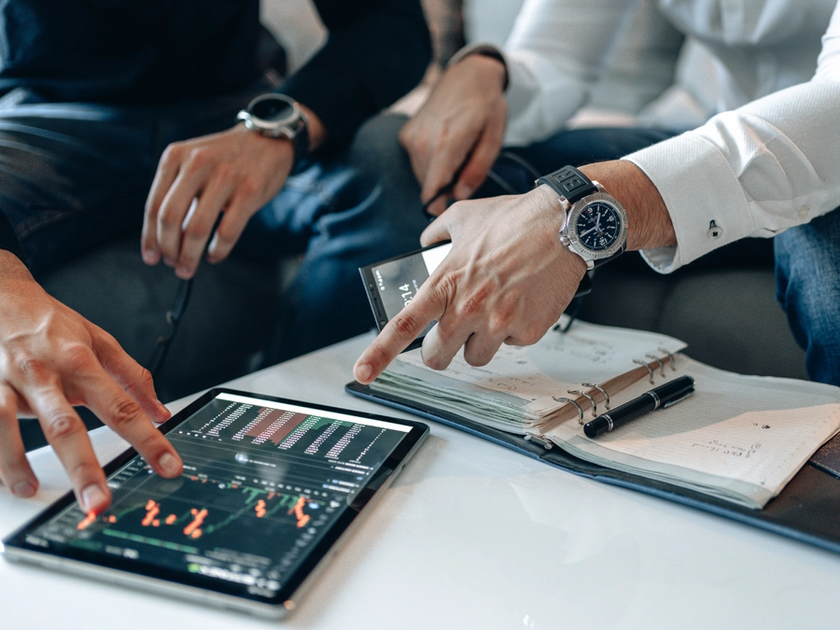What is bitcoin?
Bitcoin is a digital currency, or cryptocurrency, as it’s also called. Bitcoin is the first and largest cryptocurrency measured on market value, which in June 2022 was about 2,700 billion DKK according to Coinbase. So, if you’re interested to learn more about cryptocurrency, bitcoin is a great place to start.
In this blogpost, you can read about:
- What’s the idea behind bitcoin and blockchain?
- What’s bitcoin ‘mining’?
- Who created bitcoin?
What’s the idea behind bitcoin and blockchain?
An important characteristic for bitcoin is that it’s a decentralised currency. To understand what decentralised actually covers, and why it’s important, we could take buying a house as an example.
Example:
Back in the day, residential buying and selling happened during public assemblies
Take Albert, for example, if he wanted to buy a house from Benny, it would have to happen in front of the rest of the town during a public assembly. This way, everyone now knew that the house rightfully belonged to Albert.
If any doubts were to be raised about the ownership of the house, everyone in the town would know who owned what. But as society grew larger and larger, it no longer made sense to gather everyone in the town to witness residential trades. It became too ineffective.
Instead, central governments were formed to supervise residential trades, which were able to attest that Albert was now the rightful owner of Benny’s old house.
The central governments noted important details about the purchase of the house. If a third person, let’s say Carl, then declared that he was the rightful owner of the house, Albert could go to the central government and get proof of who the rightful owner truly was.
Bitcoin is a mix of the two methods.
Bitcoin uses a technology called blockchain . It’s a public registry where transactions - such as the purchase of a house - is written down.
At the same time, blockchain is a public distributed ledger. This means that the public has access to the registry, or ledger - and that works kind of like participating in a public assembly. The details written down in the blockchain registry are being verified by the public, just like an assembly.
The central government, who before guaranteed the authenticity of transactions, can now be maintained by the public ledger through blockchain technology.
What is bitcoin ‘mining’?
In order to create new bitcoins, people need to ‘mine’ them. Just like it was the case with gold, back when society based the economy on gold.
The creators of bitcoin made a maximum cap on how many bitcoins can be in circulation in total: 21 million. In April 2022, there were about 19 million bitcoins in circulation, while the number for April 2010, was approximately 2,7 million. You can follow the development at Statista .
As the number of bitcoins closes in on the maximum cap, it’s becoming harder and harder to find them.
That’s also why bitcoin mining is a resource-intensive process. It requires large amounts of computer-power and thus large amounts of energy, and will only grow heavier and heavier as the last bitcoins are being mined. But why are people even mining for bitcoin?
Let’s go back to the example of purchasing a house:
All transactions are registered and verified by the public via the distributed ledger.
But why should people want to spend time on that, if they’re not getting anything out of it?
When transactions are registered and verified on a blockchain, it triggers a reward in the form of bitcoins. That’s why people want to spend time and money on maintaining the blockchain network - because they’re being rewarded with bitcoins.
You can read more about bitcoin-mining here.
When you trade bitcoin , you need to be aware that it carries a large risk. The value of your bitcoins can both rise and fall, and you can risk losing the entire amount you’ve invested in cryptocurrencies.
The bitcoin story: Who created bitcoin?
Bitcoin was conceived by the anonymous character, Satoshi Nakamoto. It’s not known whether it’s a single individual or a group of individuals.
In 2008, Satoshi Nakamoto published a whitepaper, “Bitcoin: A Peer-to-Peer Electronic Cash System ”, which described the fundamental features of bitcoin and blockchain. In 2009, the idea became reality and the first bitcoin was in circulation.
The driving force behind bitcoin and blockchain was the idea of decentralising money. This means getting rid of the unnecessary intermediaries between buyers and sellers.
And why was this so important for Satoshi Nakamoto?
Intermediaries can be corrupt, and they may impose extra and unnecessary fees on transactions, which in reality could have happened directly between buyers and sellers. As Satoshi Nakamoto writes in the whitepaper:
“What is needed is an electronic payment system based on cryptographic proof instead of trust, allowing any two willing parties to transact directly with each other without the need for a trusted third party.”
Instead of basing transactions on trust, transactions need to be based on proof - just like the case is with modern banks and similar intermediaries.
But intermediaries can also be corrupt, which is why you need to trust that their proof is truthful. With bitcoin and blockchain the proof is secured by the technology: Cryptographic proof.
The first bitcoin transaction: 2 pizzas for 1,5 billion DKK
After the launch of bitcoin in 2009, it would be a couple of years before the cryptocurrency was used to make an actual transaction. It was the programmer, Laszlo Hanyecz, who became the first person to purchase an item with bitcoin.
On May 22nd 2010 Laszlo Hanyecz purchased two pizzas from the American pizza-chain Papa John’s Pizza. He paid 10,000 bitcoins for them, which at the time equaled to around 40 USD - approximately 280 DKK. Today, those 10,000 bitcoins are worth about 1,5 billion DKK.
Since then, May 22nd has infamously been known as “Bitcoin’s Pizza Day”.
How to get started trading bitcoin
With Lunar Block, getting started with trading bitcoin is easy. All you have to do is download the Lunar app, and sign up to Lunar Block .
You need to complete a test in connection to your signup, where we will ask about the risks of cryptocurrencies. You can get to know the risks in the Lunar app, before you take the quiz. Once you’re approved, you can get started trading crypto immediately.
GET STARTED WITH BITCOIN
- 1
Download Lunar for free
Download Lunar in the App Store or Google Play. Remember to have your photo ID ready.
- 2
Sign up to Lunar Block in the app
Find Lunar Block under ‘Products’ and sign up. First, you’ll be asked to take a test about crypto - among others, to make sure that you’re aware of the risks involved. You can learn more about the risks in the app before you take the test.
- 3
Buy bitcoin with a swipe
Once you’re approved, you can buy crypto right away - Bitcoin, for example - in the app, and buy with a single swipe.
Cryptocurrencies can rise and fall
When you trade cryptocurrencies, you need to be aware that it carries a large risk. The value of your cryptocurrency can both rise and fall, and you can risk losing the entire amount you’ve invested in cryptocurrencies.
Cryptocurrency trading is done through Lunar Block. Lunar Block is not regulated by the Danish Financial Supervisory Authority (Finanstilsynet). That means you won’t have the same protection as when trading e.g. stocks or other regulated assets.
We do not counsel
We do not advise on currencies and do not make recommendations for either buying or selling. We can provide factual information about the different currencies, but past price developments are not an indication of future developments.
No information from Lunar Block should therefore be considered as recommendations and all decisions are up to you alone.
Last updated April 18, 2023. We’ve collected general information. Please note, that there may be specific circumstances that you and your business need to be aware of.
You might also like...
Where can I pay with solana?
Cryptocurrency is becoming so widespread and acknowledged abroad that you can use the currency just like regular payment methods on some...
How do you buy solana as regular stocks?
Because solana (SOL) is a currency, and not a business, you can’t actually invest directly in solana like it’s a stock.
Are cryptocurrencies a good investment?
Cryptocurrencies can be a great addition to your portfolio - if you’re willing to run the risk. Cryptocurrencies are “high risk - high...
What is blockchain?
A blockchain is a digital registry, where information is stored. That could be transaction information for instance - which is what...



